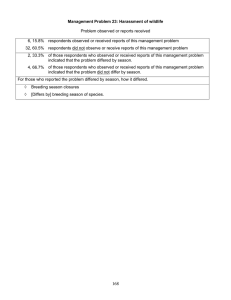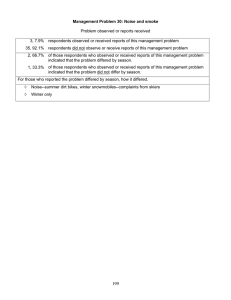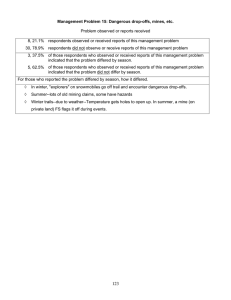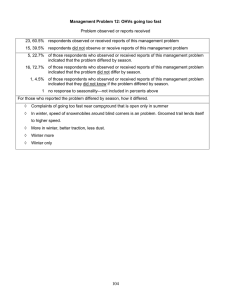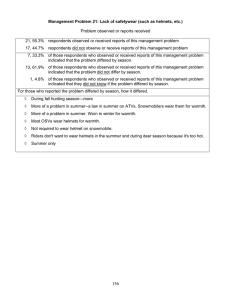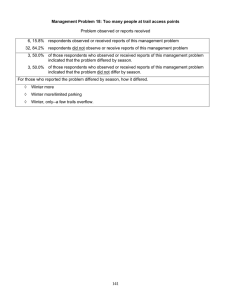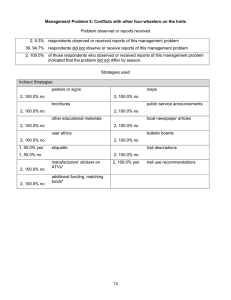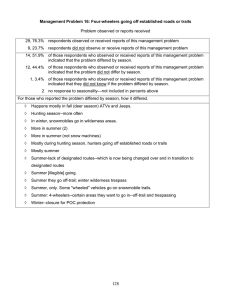Management Problem 13: Alcohol use Problem observed or reports received
advertisement
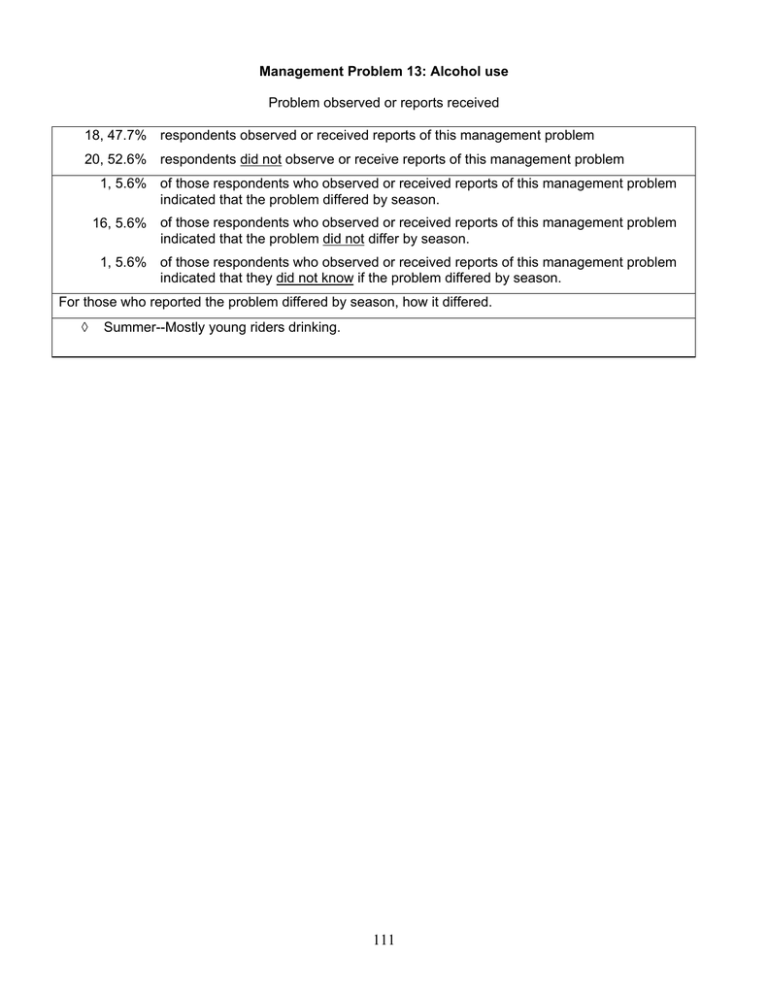
Management Problem 13: Alcohol use Problem observed or reports received 18, 47.7% respondents observed or received reports of this management problem 20, 52.6% respondents did not observe or receive reports of this management problem 1, 5.6% of those respondents who observed or received reports of this management problem indicated that the problem differed by season. 16, 5.6% of those respondents who observed or received reports of this management problem indicated that the problem did not differ by season. 1, 5.6% of those respondents who observed or received reports of this management problem indicated that they did not know if the problem differed by season. For those who reported the problem differed by season, how it differed. ◊ Summer--Mostly young riders drinking. 111 Management Problem 13: Alcohol use Strategies used Indirect Strategies 7, 38.9% yes posters or signs 11, 61.1% no 6, 33.3% yes brochures other educational materials user ethics 18, 100.0% no etiquette manufacturers’ stickers on ATVs* 1, 5.6% yes 17, 94.4% no 2, 11.1% yes 16, 88.9% no 1, 5.6% yes 17, 94.4% no 2, 11.1% yes 2, 11.1% yes bulletin boards trail descriptions trail use recommendations 16, 88.9% no 4, 22.2% yes 14, 77.8% no non-issuance of outfitter, guide, or event permits organized events to do trail maintenance relocate or designate OHV trails seasonal closures 17, 94.4% no 1, 5.6% yes 5, 27.8% yes additional funding, matching funds* 16, 88.9% no 17, 94.4% no local newspaper articles 16, 88.9% no Direct Strategies 2, 11.1% yes close or limit use 1, 5.6% yes 2, 11.1% yes 13, 72.2% no 15, 83.3% no 18, 100.0% no public service announcements 16, 88.9% no 13, 72.2% no 3, 16.7% yes 2, 11.1% yes 16, 88.9% no 14, 77.8% no 5, 27.8% yes maps 16, 88.9% no 12, 66.7% no 4, 22.2% yes 2, 11.1% yes 17, 94.4% yes provisions for special use permits law enforcement 1, 5.6% no 1, 5.6% yes users ride in dispersed patterns 17, 94.4% no 1, 5.6% yes separate trails 17, 94.4% no 1, 5.6% yes separate user groups 17, 94.4% no make repairs as soon as located* alternate between user groups 18, 100.0% no pick up litter* 18, 100.0% no 18, 100.0% no voluntary sound tests* 18, 100.0% no 112 use OHV trail crews to maintain trails* Management Problem 13: Alcohol use Resource Hardening Strategies Specify a maximum grade on 1, 5.6% yes trails? 17, 94.4% no mean =15.0000 1, 5.6% yes 17, 94.4% no artificial tread (e.g., geofabric with sand and gravel, concrete blocks) What percent? (mean & only response) Specify a minimum grade? 1, 5.6% yes 17, 94.4% no 18, 100.0% no lengthened trails to disperse riders What percent? n/a 1, 5.6% yes 17, 94.4% no drain dips (meaning a reversal of grade) flexible water bars 18, 100.0% no 18, 100.0% no 18, 100.0% no 1, 5.6% yes 17, 94.4% no 1, 5.6% yes designated campsites 17, 94.4% no for events, restricted to one direction (e.g., uphill or downhill)* trail design: limit long straightaways/use all single track/ use natural obstacles* barricades, barriers* 18, 100.0% no 18, 100.0% no rolling dips, dog bones* 18, 100.0% no staging areas with parking facilities 18, 100.0% no 113 general trail maintenance including consistent, mechanized & 3-year plan* overflow parking and staging areas* Management Problem 13: Alcohol use Bridge Building/Collaboration Strategies 16, 88.9% yes personal contacts 2, 11.1% no 4, 22.2% yes local OHV club meetings meetings with state OHV groups adopt-a-trail program 17, 94.4% no 2, 11.1% yes trail safety evaluation form education, including campfire programs* joint clean-ups with BLM* 2, 11.1% yes workshops 1, 5.6% yes committees with different 17, 94.4% no groups 2, 11.1% yes maintain trail with local groups and volunteers 16, 88.9% no 1, 5.6% yes working with sheriff’s dept.* 17, 94.4% no 18, 100.0% no mine safety evaluation form* 18, 100.0% no 18, 100.0% no partner with OHV shops 16, 88.9% no 17, 94.4% no 1, 5.6% yes volunteer patrols 16, 88.9% no 14, 77.8% no 1, 5.6% yes 5, 27.8% yes 13, 72.2% no 16, 88.9% no 4, 22.2% yes partner with different groups 15, 83.3% no 14, 77.8% no 2, 11.1% yes 3, 16.7% yes 18, 100.0% no find out from users and environmentalists where trails should be* * Strategies added by respondents in response to open-ended questions. 114 help from regional office and state* Management Problem 13: Alcohol use Strategies reported “used most often” 8, 47.1% personal contacts 5, 29.4% law enforcement 2, 11.8% posters or signs 1, 5.9% local OHV club meetings 1, 5.9% working with Sheriff’s Dept. Strategies reported “most effective” Why “most effective” 9, 50.0% personal contacts 115 ◊ Due to the interaction with visitors, chance to explain in more detail why there are rules, answer visitors’’ questions, etc. ◊ The "FS presence" whether to help or enforce regulations is effective. Use motorcycle patrols to be "one of them." Someone who has "riding ability" and can "talk bikes" with users. ◊ Using alcohol makes them uneasy--they will comply if they know they will have vehicle searched. Use a check station--talk to everyone and tell them not to drink/may be searched. ◊ Talking to someone is better than leaving a note on info board (won't get read). Message gets across better. People get tired of reading negative posters. ◊ Personal contact is more effective than, say, a passive poster. ◊ Dialog between user and us is important. Give them "a why." Explain to them. ◊ Not a specific law for a long time. FPOs don't really do law enforcement (law enforcement is also personal contact). Peer pressure. ◊ Gives users an opportunity to ask for clarification of the rules; lets the users know that we are keeping an eye on the resources. ◊ Gets attention of users. Management Problem 13: Alcohol use Strategies reported “most effective” (continued) Why “most effective” (continued) ◊ People don't tend to drink when Law Enforcement is present. ◊ Educate/provide consequence for actions. ◊ Dealing with underage drinking and of-age, but irresponsible. ◊ You can post signs and talk all you want, but change really happens when the tickets start getting written. (FS LEOs working with County Sheriff) ◊ They seem to listen closer to LEO. ◊ no response (1) 1, 5.6% posters or signs ◊ Information is "in their face" to read. They have had specific signs made for this and posted on trail and at trailhead. 1, 5.6% user ethics ◊ Getting them to do it on their own means more than a ticket. Used to do law enforcement but unarmed FPOs can't do it. When alcohol is around, (FPOs) don't deal with it because unarmed. (Need to) call cops who aren't available much. 1, 5.6% working with Sheriff’s Dept. ◊ Do 15 minute program. Kids pay attention but hard to know how well it works. Haven't found much that works. 6, 33.3% law enforcement 4, 22.2% of those respondents who observed or received reports of this management problem indicated that their strategies differed by season. 14, 77.8% of those respondents who observed or received reports of this management problem indicated that their strategies did not differ by season. For those who reported their strategies differed by season, how they differed. ◊ Areas are closed to ATVs in winter where we don't want them damaging trails that could be a safety hazard to others (rutting). ◊ Change with fire, wet weather, spring. Restrictions in spring to avoid fawning, nesting, and frogs in aquatic areas. ◊ Hunting season ◊ During hunting season--do more LE. 116
